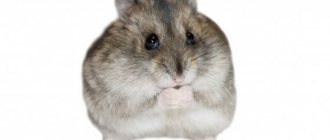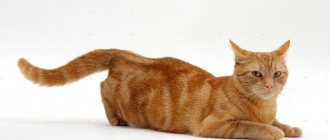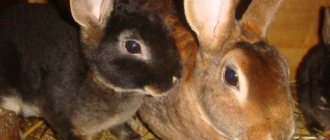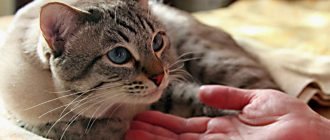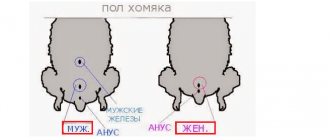Mating process
Beginning rabbit breeders are wondering how to breed rabbits correctly.
In order to get healthy offspring, you should take the selection of individuals of different sexes seriously. Mating takes place from 1 to 6 days. You should always monitor the behavior of individuals so as not to miss insemination. A healthy female is placed with a male (not vice versa, since the male will be busy exploring a new home) and they are monitored for 20-30 minutes. In no case should individuals be left together for a long time, because insemination can be double. The first litter may be early, and the second, on the contrary, late (the uterus consists of two sections, so a double pregnancy can occur). This is very harmful to the health of rabbits. In this case, premature rabbits remain in the female’s uterus, which can be dangerous for the rabbit’s life.
During the mating of rabbits, owners can expect failure, especially when rabbits of different breeds are bred. If there is a suspicion that the rabbit has not become pregnant, after 5 days she needs to be placed next to the rabbit again and her behavior monitored. If the female allows the rabbit to approach, then insemination has not occurred. If the partner fails again, the partner should be replaced.
Favorable age and season for first mating
Depending on the size of the breed, the female reaches sexual maturity at the age of 4-5 months, males mature later, at 5-6 months. However, experienced farmers do not recommend carrying out the first mating in the early stages.
Breeding rabbits is quite a profitable activity.
At what age can you breed rabbits for the first time:
- The ideal age for breeding in females is 5-6 months, in rabbits - at 7 months and later.
- It is not recommended to delay the mating of animals - with late mating, the maternal instincts of rabbits are reduced.
- During the molting period, the animal spends considerable energy changing its coat. Females are allowed to mate after the first molt (at 4-5 months), males - after the second (at 7 months).
- The weight of a young individual before mating should be 2/3 of the weight of an adult rabbit: for large breeds - 3.5 kg, medium - 2.5 kg or more.
Domestic rabbits breed all year round. One mature female rabbit produces up to 7 litters per year. Each brood contains 7-10 cubs.
For the first mating, a seasonal period with an air temperature of 20-22 ° C is selected. In May–June, animals show increased activity; long daylight hours stimulate the female to mate.
Timing of fertilization
Female rabbits can become pregnant as early as 4 months, while males reach puberty a little later. At the first signs of sexual heat in a female rabbit, she can be allowed near a sexually mature male. The first time females are mated after the animal has had its first molt. Males can breed only after their second molt. In order for the offspring to be healthy and its quality to be at a high commercial level, experienced owners recommend carrying out the first mating at the age of six months. Before this, the baby rabbit had not yet formed itself and was not ready for additional stress on its body.
1-3 days after giving birth, the female may become ready to mate again. The hunting period lasts up to 5 days. It is believed that winter slightly slows down the processes of sexual activity in rabbits, so there may be some deviations from the indicated dates.
Attention! If the female is planned to give birth in the cold season, then the cages should be insulated. If animals are raised in special pits, then it is necessary to ensure individual protection for the female rabbit and future offspring.
What rabbits are suitable for mating?
In order to carry out the mating process correctly, you should know at what age rabbits can be bred. At 6-7 months, animals are ready to reproduce. At this stage of life, sex hormones begin to play in them. In order to get healthy offspring, animals need to be chosen that are large, healthy and active. Females suitable for mating are the first or second litter (as a last resort, the third).
The body weight of animals must be at least 3 kg. It is better to immediately cull phlegmatic animals and keep at least two breeding rabbits on the farm. You should not mix males with females that have not fertilized after several inseminations.
Before breeding, you should know not only what age the individuals are, their health and mood, but also the breed of the animal. Experienced rabbit breeders can mate not only purebred rabbits, but also conduct interbreeding.
At what age should rabbits mate (age of mating rabbits)
Rabbits are very fertile and everyone probably knows about it. There is even an opinion among people that rabbits mate (regardless of age) always and everywhere. And, nevertheless, many owners who start breeding rabbits often wonder - at what age should rabbits be mated?
The age of mating depends on many circumstances: you need to take into account weight, molting period and how many months the animal is.
The first moult in rabbits ends at the age of 4-5 months, and the second at about 7 months. The timing of molting and the difference in the rate of puberty of males and females determines at what age rabbits should be mated: females need to be mated after the first molt, and males are ready for mating only after the second.
Before starting the breeding process, it is necessary that female rabbits of large breeds (white giant, gray giant, silver) reach a weight of at least 3.5 kg, and female rabbits of medium breeds (Viennese blue, chinchilla, Angora downy) weigh at least 2.5 kg (i.e. about 60% of the body weight of an adult animal).
The female rabbit must be prepared in advance for mating. They should be kept no more than 2-3 pieces in one cage, the premises should be well lit, since lack of lighting leads to inhibition of the process of puberty. On the eve (approximately a day before) mating of females, you need to carefully examine the genitals, nipples (normally there should be 8-10 of them), and the skin for damage and rashes. If a rash or discharge is noticed, then such females are discarded and not allowed to mate. Both thin and overly thick females are not suitable for mating (the most normal weight is slightly above average). After 4 months, female rabbits quickly become fat and their productivity noticeably decreases.
In males, puberty occurs somewhat later and they can mate no earlier than 6 months of age. Males for breeding work are selected especially carefully. They must be healthy, developed, well-fed and active. The male must live alone in a cage. If, upon examination, injuries are found or the rabbit is somewhat lethargic, then mating will have to be postponed.
Females mature faster if they were born in winter and can be allowed to mate a month earlier. During seasonal molting, animals become weakened, so rabbits should mate only after it has ended. Large breed rabbits are ready to mate 1-2 months earlier than their obese counterparts. A poor diet (low protein) and poor lighting can delay puberty in rabbits.
Females can be allowed to mate after 5 months (of course, in the absence of active molting). The animal must have a weight sufficient for the given breed. The weight norm for each breed is different, but the optimal body weight for mating ranges from 2.5 to 3.5 kg.
Too early mating can have a negative impact on productivity. A late start to breeding will also have a bad effect on productivity.
The key to success in rabbit breeding largely depends on a carefully prepared first mating. If your animals live in comfortable conditions, receive complete succulent food in winter and green food in summer, roughage and have free access to water, then they will certainly appreciate the care of the owner and will reward them with large litters.
You will find advice for novice rabbit breeders on the page.
You might be interested
Compacted litters
When breeding rabbits of meat breeds, rabbit breeders often face the question of compacted litters. Mother nature itself has given rabbits the ability to combine pregnancy with lactation. And man has only just applied this technology...
Rabbits for the summer or all year round?
There are two ways to keep rabbits. The first method is when rabbits are kept only in the warm season (spring-summer). Small rabbits are purchased with the appearance of the first greenery. The number of rabbits purchased depends on your appetite and ...
Breeding rabbits at home (breeding basics)
Breeding rabbits at home is an interesting and profitable business. Today I will try to cover this topic and maybe you will want to breed rabbits. You can breed rabbits by purchasing adult purebred individuals...
Which rabbits are best to breed?
Do you want to start breeding rabbits? The idea is good, but first you need to answer the question - what do you want from your home farm? Meat, skin or both? More popular...
Keeping and breeding California rabbits at home
Breeding rabbits is a very interesting activity, but at the same time, it requires certain knowledge. For a novice rabbit breeder, every little detail is important when choosing the right breed. And the ability of rabbits to adapt to climatic conditions...
Selection of partners and formation of pairs
The sexual maturity of domestic rabbits is not yet a decisive factor in order to have partners and receive offspring from them. This issue needs to be approached more carefully. A healthy generation cannot be obtained from close relatives, so only rabbits from different parental lines are left for the tribe.
Rabbits are bred only from the best individuals. When breeding, it is important that both partners meet breed standards. Culling will only produce outbred young animals. At the time of mating, the weight of rabbits should be about 3 kg; if the female’s weight exceeds this figure, then it will be more difficult for her to become pregnant. Both animals must be examined for diseases before having sexual intercourse.
Rabbit breeding
In addition to all this, rabbits selected for breeding must be distinguished by good fertility, sexual activity and parental instinct.
During the hot season and extreme cold, rabbits are passive and refuse to mate.
When forming a pair, the following criteria are taken into account:
- Only healthy animals are used for mating.
- Individuals born from the 1st to 3rd birth or in winter have the best productive properties. The maximum age of rabbits for breeding is from 1 to 3 years.
- Experienced males or females are selected as partners for young rabbits.
- It is strictly forbidden to carry out related matings, especially close and closely related inbreeding.
- Rabbits must display the best traits and qualities of the breed.
When forming pairs, it would be ideal to carry out several matings at the same time. This will be able to mutually compensate for excesses or shortages of rabbits in litters.
Crossing methods
Several methods are used to breed rabbits. Let's look at them in more detail.
- The first method is to briefly place the female with the male. How long it takes before mating depends on both the male and the mood of the female. This can be from 20 minutes to 2-3 hours. All this time, the rabbit breeder must observe the behavior of the animals and not miss that very moment. The coating lasts about a minute and is not difficult to determine. After the process is completed, the male falls on his side and makes a squeak. This means that it’s time to seat the long-eared ones.
- The second method is based on a longer replanting - 5-6 days. Here the animals decide for themselves when to mate and can settle down for a while. Fights often happen, but this is the case when you don’t like your partner. Therefore, at first it is recommended to observe the behavior of rabbits. If the animals do not get along, then they are seated.
- Animals can be mated not only naturally. There is also artificial insemination. At the moment of covering the female, a test tube is inserted to collect seminal fluid, which is then injected with a special syringe into females ready for mating.
It is interesting to know that breeding rabbits are selected immediately after birth. They are distinguished by their activity and large size.
Animal culling
2 weeks before mating, rabbits are carefully examined.
Rejection criteria:
- Age over 3 years.
- Loss of maternal instinct and killing of offspring. Frequent mating leads to exhaustion of the body, the rabbits are born weak and non-viable.
- Repeated miscarriages in the female rabbit and stillbirths.
- The presence of diseases, rashes, abrasions, tumors, purulent discharge and unhealthy condition of the reproductive organs. Animals are inactive, have a weak appetite, physical injuries to their paws and other abnormalities.
- Underweight or overweight. Excessively obese animals inactively engage in mating or completely refuse to mate. Skinny rabbits have weak, non-viable offspring.
Be sure to read:
How to determine the sex of a rabbit: external differences, sexual characteristics, behavior
Culled but healthy rabbits are fattened and sent to slaughter. Individuals with external signs of the disease are urgently destroyed.
Many farm owners have seen how domestic rabbits copulate, so they can confidently recommend securing the cage for the mating period and removing all foreign and sharp objects. Animals can run and maneuver very quickly in a limited area, so any obstacle or dangerous object provokes injury.
A week before domestic rabbits begin to mate, they are transferred to a special diet with a high content of vitamins and minerals. A good diet compensates for future losses of the animal’s body during bearing and feeding offspring. In winter, it is advisable to install lamps and thus increase the length of daylight hours.
Mating after childbirth
Before mating begins, it is important to determine the female rabbit’s readiness to accept a male and hatch the young rabbits—the beginning of the hunt. The main sign of heat is the swollen genitals of the female rabbit with a bright pink color.
In the sexual cycle, the period is repeated several times a month: duration is 1-2 days every 5-7 days in summer and 9-10 days in winter.
To provoke a female rabbit's desire to mate, it is necessary to place a cage with a male nearby.
Another sign of heat detection: if you stroke a female rabbit on the back, she will stick out her butt. During this period, females do not like to be picked up. Animals behave restlessly, lose their appetite and may completely refuse food.
To provoke a female rabbit's desire to mate, it is necessary to place a cage with a male nearby - the smell of the rabbit will speed up the onset of hunting.
How to prepare a rabbitry for hatching:
- Extend daylight hours to 16 hours. In winter, fluorescent lamps are installed in the rabbitry.
- Before hatching the litter, a nest box must be installed in the female's cage. It is covered with straw and paper. This is where the rabbit will lay her fur. At the first birth, the owner himself must carefully pull the fur out of the animal’s belly and place it in the nest.
- To exclude infectious diseases, the premises, cells and equipment are disinfected. The frequency of preventive maintenance for rabbit hutches is at least 2 times a year, cages – before mating and after illnesses. For whitewashing walls, a solution of freshly slaked lime is used. Equipment, feeders and drinkers are washed with a 2% solution of soda ash or a solution of potassium permanganate. For chemical treatment of cells, antiseptic agents: 1.5% ammonia chloride solution, 2% dezmol solution, 40% formaldehyde solution.
- Before mating, rabbits must be vaccinated.
Developed parental immunity is inherited by the offspring
. How do rabbits reproduce:
- Feeders and drinkers are removed from the rabbit cage. The female is placed next to the male for 2-3 hours during the hunting period. After replanting, the couple must be observed for several hours. If the female rabbit is aggressive towards the male, then the mating process has failed.
- The couple is placed in a separate cage and kept together for 5-7 days. Animals independently choose the time of mating. It is necessary to control the rabbits for some time to prevent fights between partners.
- In large farms, artificial insemination is practiced. At the moment of mating, the rabbit's sperm is collected in a test tube. The female is artificially inseminated by injecting sperm using a syringe. The method gives a 95% guarantee that the rabbit is pregnant the first time.
Be sure to read:
We suggest you read: When do kittens’ teeth change? 30 photos Do cats and kittens have baby teeth? Symptoms of changing teeth to permanent ones
How long do rabbits live depending on the breed, what affects life expectancy, how to extend
The act of mating takes place quickly - within 30 seconds. If sexual intercourse is successful, the rabbit falls to the side with a whistle and freezes for 5 seconds. The female is urgently placed in another cage, otherwise the male may bite the fertilized rabbit.
Physically, the female rabbit is ready for re-mating already on the 2-3rd day after giving birth. Theoretically, a female can give birth to up to 10 litters per year.
However, mating during the period of mother's milk production will lead to exhaustion of the female's body and a decrease in maternal instincts.
The optimal number of litters per female is up to 7 per year; female rabbits are mated on the 20th day after the birth of the young. After a year of intensive breeding, the female is culled and sent to slaughter.
If, after several litters, the female chases the male and looks tired and lethargic, it is recommended to give the female rabbit a rest for 1 month. After rest, the animal will return to reproductive functions.
Some tips for mating rabbits at home for novice rabbit breeders:
- Buy rabbits only from trusted farms or from people you know. Dishonest market sellers may sell sick or culled animals.
- Grass is the favorite food of long-eared animals. In the summer, give the rabbits more freshly cut grass, and in the winter - meadow hay. Be sure to check the grass for the presence of harmful plants: henbane, belladonna, weedweed.
- Try not to get carried away with childbirth, but leave the cubs with their mother longer. Rabbits grow faster and have greater vitality.
- Rabbits are demanding about cleanliness. Daily cleaning of cages is a necessary condition for the healthy keeping of a pet.
- It is better to slaughter rabbits in winter in December and January. Hang the gutted carcasses in the cold so that the meat freezes well. There will be a delicious dietary dish for the New Year.
Before breeding rabbits, you should prepare as seriously as possible for this process. Over the course of 2 weeks, the selected individuals are examined and their diet changes for the better. It is important to know their health status and weight. If a rabbit is sick, it is not allowed to breed, and if it is underweight, it means that it is transferred to a high-calorie diet.
An important point in the examination is the number of nipples the female has - there should be 8-10 of them. There should be no scratches, abrasions or rashes on the external genitalia (such individuals are discarded). Also, animals that are actively molting are not suitable for mating.
Nutrition before mating is important. Males are fed with potatoes and oats, and females with concentrated food, tree branches and hay (in the same quantity). Overfeeding animals is harmful, because their performance indicators are significantly reduced.
Ovulation of rabbits plays an important role in reproduction. In summer, the egg is released every 5-7 days; in winter, this process slows down a little and the interval increases to 8-9 days.
The female rabbit's readiness for motherhood is the main stage of preparation for mating. This is the hunting period and lasts from 3 to 5 days (depending on the season). In winter, the sexual activity of the animals decreases slightly.
It is easy to determine whether a female is ready to reproduce:
- builds a nest from branches and hay;
- pulls out fluff on belly;
- activity increases significantly;
- the genitals become red and enlarged.
Males do not have such distinctive features. It is important to prepare his cage for mating.
The pregnant female should be completely at rest. The animal is kept in another cage, which should always be dry and clean. It is not recommended to pick up the rabbit during this period. Diet is very important. The animal is fed high-quality food: hay, cereals, legumes, succulent food (cabbage, carrots, washed potatoes).
A few days before giving birth, females build a nest from straw and their own down. There should always be fresh water in the cage (slightly warmed in winter).
After giving birth, the female rabbit can be born as early as the next day, but an experienced rabbit breeder will not rush, because this can negatively affect future offspring. They may be born weak and small. It is recommended to carry out the next mating in 2-3 weeks.
Features of puberty in rabbits of different breeds
Puberty of rabbits begins at the following ages, taking into account the breed:
- For large-sized animals, this is the period when the animal matures and reaches the age of 4 to 5 months.
- For medium-sized breeds, the time of puberty for females and males is reached at approximately 3.5 months of age.
- In toy breeds, this process begins when they become 3 to 4 months old.
Please note that in most cases, puberty of the male and female rabbit occurs after the first molt. But, readiness for the breeding process does not mean that these domestic animals can be allowed to breed. Despite the fact that during the indicated periods the animals have already reached puberty, it is still worth waiting for the breeding process.
For females, mating is recommended at the age of no earlier than 5 months. Most often, by this period the animal manages to gain about 3.5 kg of live weight.
But it is better to allow male rabbits into the breeding process, starting from 6 months, or even 8 months of age.
In this case, it is necessary to monitor when the appropriate process for reproduction occurs. In females it lasts from 3 to 5 days. In warm seasons, the intervals between sexual estruses repeat approximately every week or slightly more often. When the temperature drops, sexual estrus repeats after 9 days.
Jigging methods
Weaning small rabbits is important. For rabbit breeding, it is recommended to plant at 45 days. There are two methods of depositing:
- Removal of the entire brood at the same time.
- The female is taken away from the babies and sometimes returned for 1-2 days.
- Seated gradually. First the strongest and strongest, and over time those who are weaker.
After transplanting, the young animals are weighed and placed in different cages. Some (strong and strong) will serve for reproduction, others will be used for meat.
Standard technology
Mating of animals is carried out in the morning or evening, in the cold season it is better in the middle of the day. Everything unnecessary is removed from the cage (so that the animals do not harm themselves during increased activity), including food, a feeder and a drinking bowl. Next, you need to thoroughly wash and disinfect everything.
Young females are paired with experienced males. If the female rabbit is in heat, she freely allows the male to approach her. If coverage does not occur, the animals should be mated again after a couple of days.
At industrial enterprises, rabbits are well fed so that puberty begins earlier. Mating usually occurs on the 20th day after birth. Rabbits in industry reproduce by double mating. This is the only way to be sure that insemination was successful. To do this, first one male is allowed near the female, and after a couple of days a second male is allowed in. The probability of fertilization increases many times. This pairing guarantees healthy and strong babies.
Pregnancy, as stated above, lasts no more than a month. On large farms, females with good productivity are selected, which can give 7 litters per year. Afterwards they are discarded.
Healthy and strong offspring can be obtained if the next mating of the female occurs 30 days after giving birth. After 14 days, the already grown-up rabbits are taken away, and after another two weeks they wait for the next birth of the babies. With standard technology, about 40 young animals can be produced per year.
A female rabbit can be used for mating with a male for more than two years. For further reproduction, the best females are selected from birth. You can see rabbits several times a year, and winter is no exception. In small farmsteads this method is most often used.
How to properly breed domestic rabbits to get healthy offspring? In summer, they choose early morning or evening for mating; in winter, the middle of the day. The female is placed in a cage with a male.
We invite you to familiarize yourself with Dwarf pigs, also known as mini-pigs: how to buy and keep such a piglet || How much does a dwarf pig cost?
Attention! An experienced male is given a young rabbit, and a young rabbit is given an experienced adult female.
If the animal is in heat, it will immediately willingly allow the male to approach it. Mating continues for several seconds. After ejaculation, the rabbit tends to squeak and fall to the side, there is nothing wrong with that. After 5 days, control mating is carried out. However, there is some risk in this procedure.
How to breed rabbits correctly
Mating of rabbits (copulation) is the coordinated actions of a rabbit and a female rabbit, as a result of which the sperm enters the female genital tract, where the male and female cells merge.
For successful mating, it is better to use an experienced male with a good sexual constitution, and place the female rabbit in the rabbit’s cage, and not vice versa. The load on an adult male is 5-10 females. The daily load per male is four females. Mating is carried out in the morning or evening in the summer, and in the afternoon in winter. The date of the sexual intercourse with the male’s number is entered into the female’s card and vice versa, the number of the mated female is entered into the male’s card. Control mating is carried out after five days.
Photo. The female rabbit is placed next to the male
Mating schedule and male diet
It is difficult to record the moment of coverage during mating games. At first, the partners run after each other, then the female stops and presses herself to the floor.
If the chase continues for a long time, the female is held back and the rabbit is allowed to mate.
It is difficult to record the moment of covering during mating games.
To guarantee, after resting for 5-10 minutes, re-covering is carried out. After mating, the female rabbit is placed in a separate cage, and the date of mating is recorded in a journal.
During the mating period, one male is able to fertilize up to 8 females. The intensity of mating of a male is no more than 2 rabbits per day: in the morning and in the evening.
It is better to mate young males no more than 5-6 times a week.
2 weeks before mating, it is necessary to adjust the rabbit’s nutrition. Food should be high in calories and rich in vitamins.
The diet includes boiled potatoes, concentrated feed (CC, PC), leguminous and cereal crops (oats, wheat bran, corn), oilseeds, mixed feed, cakes, feed yeast, mineral supplements and vitamins.
Random and forced inbreeding
When related animals mate, the process is called inbreeding. Experts have proven that this approach negatively affects the health of rabbits. Despite this, experienced rabbit breeders consciously practice this method to breed new breeds.
Types of inbreeding:
- accidental - this is when mating occurred due to the fact that the young animals were not separated into different cages in time;
- forced - they consciously mate rabbits of relatives to breed a new breed.
Crossbreeding of animals related by blood is harmful to their health. If this happened by chance, then in this case, a rabbit from another offspring is bought and placed with the female to dilute the blood.
Reasons for random inbreeding:
- breeding within one small holding, farm;
- random covering in cages with unseated young rabbits;
- Inbreeding is inevitable when pitting animals.
As a result, a family with developmental disorders consistently passes on these anomalies to new generations. For example, the offspring of a female rabbit with weak maternal instincts or weak milk production copies these shortcomings.
Be sure to read:
Tanning rabbit skins at home: step-by-step instructions on what is needed for processing
Close inbreeding is very dangerous: father - daughter, mother - son, sister - brother; closely related: cousins - sisters, uncles - nieces.
Gene mutation leads to the fact that ugly, weak and with physical abnormalities rabbits are more often born in the herd. As a result, the viability of the offspring gradually decreases.
In order to avoid inbreeding, it is recommended to create parental pairs from rabbits from other farms.
Forced inbreeding is used in breeding to develop new or improve existing breeds.
Forced or accidental inbreeding
Inbreeding or, more simply, inbreeding also occurs among experienced rabbit breeders. When keeping a herd together (in a pit, enclosure, etc.), random crossings periodically occur.
Another problem is the inability to find a match for your own animals that is suitable in terms of health, appearance or breed. Then inbreeding becomes forced.
Dozens of scientific papers have been written about the pros and cons of inbreeding, so without going into unnecessary details, we will give an example from practice. Even ancient pastoralists sought to exclude the crossing of closely related animals. It has been experimentally verified that regular inbreeding in a herd leads to degeneration. Although in laboratory conditions, inbreeding is practiced to breed new breeds.
Possibility of inbreeding when kept in a pit
If, for some reason, inbreeding does occur on your farm, then experienced rabbit breeders are guided by the following recommendations:
- They try in every possible way to prevent the crossing of born rabbits with other relatives on the paternal or maternal side. Based on this, in a small herd, all rabbits born from such a cross will most likely go to meat, and will not participate in reproduction in the future;
- With forced inbreeding, they try to select a couple with the weakest family ties possible, that is, distant relatives. Given the fertility of rabbits, this is quite realistic;
- All rabbits born with congenital defects, and there will be more and more of them with each subsequent inbreeding, must be removed from the herd.
How to choose a female for mating?
With females the situation is somewhat different. Their sexual maturity occurs after the onset of the first heat or estrus - such periods can occur either at three months or much later. However, at the age of three months, you have to wait for the first mating, since there is a possibility that the female rabbit simply will not be able to bear her offspring.
At this age, the young rabbit still continues to form her skeleton and develop her body, including the endocrine system. Rabbits born from such a female will be weak and most of them will die, and after an unsuccessful pregnancy, the female will no longer be able to give birth.
Baby rabbits in a cage
In addition to rabbits that are too young, females with the following problems are also not suitable for breeding:
- During the previous pregnancy, the female was able to become pregnant only after the third mating, or even later;
- in the previous two offspring, there were less than five rabbits in total;
- The mother rabbit killed her babies.
Estrus, or, as it is also called, the period of sexual heat, can occur in a female rabbit several times a year. For example, in the summer months it happens at least once a week and lasts from two to six days. In the winter, cold months, a little more than a week, about 8-9 days, can pass between two hunts.
Rabbits spend most of their lives either in pregnancy or in heat.
However, females can also be mated on other days when they are not in heat. This is because ovulation occurs with almost every sexual intercourse; it manifests itself as a natural reflex. This helps to delay or bring forward the mating process and, accordingly, the birth of rabbits.
But, ideally, you need to make sure that the mating coincides with the hunting period - then there will be more chances for a successful mating. How to understand that the hunting period has come? Quite simple, you just need to watch the rabbit. On such days they experience:
- swelling of the external genitalia, change in color;
- low animal appetite;
- more active behavior, abrupt, perhaps somewhat aggressive.
A swollen loop is a sign of the female’s readiness for mating.
Sunlight also greatly affects the attraction of female rabbits to the opposite sex, but it is believed that the best time for mating is winter. At such times, little rabbits have to fight for survival in a cold environment, which means they will grow stronger and more resistant to any situation. Also, these babies grow quite quickly. But the final decision for mating remains with the owner, because animals have the ability to reproduce year-round.
During mating, the female may not allow the rabbit to approach her. Then, experienced rabbit breeders advise placing the animals in different cages for one day and repeating the ride again.
Often the rabbit does not allow the “boyfriend” to approach because of her coquetry. Then you can do the following. Tie a ribbon to the female's tail and wait for the right moment. As soon as the rabbit approaches for coverage, the tape should be raised along with the tail. This option is great for mating decorative rabbits. If you don’t have time to tinker with this, then at the right moment just hold the rabbit for a few seconds.
Not everyone understands why a mature female rabbit does not allow the rabbit to approach. The female can be prone to aggression, in which case it is recommended to remove her immediately. Repeated mating is carried out in the morning or evening of the next day. If reciprocity does not follow, then you will have to choose another partner. Sometimes extraneous noises interfere with mating of rabbits.
After 2 weeks, the rabbit is checked for pregnancy by palpation.
In this case, the rabbit is removed and mating is repeated after 20–30 minutes.
Before mating, the female must be prepared:
- 1st method. The rabbit is manually placed on her stomach with her paws tucked, her tail is raised and she is held by the ears, limiting her movements.
- 2nd method. A rope is easily tied to the rabbit's tail. When the rabbit attaches itself to the female, the rabbit's tail is slightly raised with a tied rope. The female is held by the ears.
You can force a female rabbit to become pregnant only during the hunting period. If the female is not in heat, pregnancy occurs with a 10% chance. In other cases, such an action can end in failure, even death.
How to determine a female's readiness?
The female's readiness to mate can be determined primarily by her behavior: during the hunting period she eats poorly, is restless, rummages in the litter, and if you stroke the rabbit, she raises her butt. However, a more reliable indication of the female’s readiness is the state of her external genitalia: the rabbit’s loop at this time is bright pink and enlarged. Mating is quite successful even when the loop has already turned slightly blue, but is still elastic and enlarged. During the rest period (if the hunt is over or fertilization has occurred), the loop acquires a pronounced bluish tint, loses its elasticity and returns to its normal size.
The female rabbit's hunt lasts 5–6 days, this cycle is repeated on average after half a month (if the female is sufficiently fat and healthy). If the animal is inactive for a long time, as well as during the autumn and winter periods, to enhance sexual activity in the diet, increase the content of vitamins A and E. Vitamin A is rich in red carrots, grass, pumpkin, fish oil, corn, vitamin E - whole grains, cake, green feed, alfalfa meal. A better way to fortify the diet is to use concentrated fortified feed and/or vitamin preparations for rabbits.
You can stimulate the female rabbit by simply transplanting it into the cage where the rabbit was previously, or by placing the baby rabbits away.
Usually the female rabbit is ready for mating in the first days after giving birth. If signs of readiness are expressed and this does not contradict your plans, the female can be placed next to the male - she will easily cover herself and bring a good offspring, since the time after childbirth is the most favorable period for mating.
Mating at home
At home, rabbits mate just like on farms, so breeding is no different from professional processes at large enterprises. It is only important to note that the cages in which the animals will be kept should be in a quiet and slightly ventilated place.
We invite you to find out how many days does a female rabbit carry baby rabbits?
It is recommended to cover several rabbits at once. This is in case at least one is unable to feed due to low milk production, her cubs are transplanted to another female.
Mating rabbits, reasons for the sexuality of rabbits
The frequent mating of rabbits and the ability to reproduce quickly has been proven in Australia. This is how their reproductive system works; see reproduction for more details. At first there were no rabbits on this continent, but now they are a national disaster. Breeding rabbits at home, under human guidance, is another matter. There are six or seven known reasons when a rabbit does not become pregnant due to human fault.
Photo. Rabbits mating
Mating of decorative rabbits
Those who decide to breed decorative rabbits should know that the process of breeding indoor rabbits is labor-intensive. Before mating, the owner must organize all the necessary conditions in the nursery and study the basics of veterinary medicine and genetics. Decorative rabbits, compared to industrial ones, are weaker in terms of health. Often there are infertile individuals and females who cannot feed their offspring.
Decorative rabbits also begin to mate at 7-8 months. Preparations for mating should begin with proper feeding and checking for diseases. Animals must be healthy and well-fed (not obese).
To mate, rabbits of different sexes should be placed in the same cage for 7-9 days. From time to time you need to monitor their behavior, because sometimes it happens that individuals do not like each other and for this reason fights occur. If everything is normal, then the males cover the female in the near future.
Free mating of rabbits
A distinctive feature of this method is the constant presence of the male in the herd with the females. This method is used when keeping rabbits in pits and burrows. This is the easiest and simplest method of mating rabbits for the purpose of reproduction.
The method is recommended for hobbyists starting to breed rabbits at home. The only thing that is required of the rabbit breeder is to calculate the number of males per female. The calculation is simple, approximately one male per ten females.
Photo. Feeding baby rabbits with milk is not a reason for a rabbit to refuse another pregnancy
In the future everything is simple. The male easily determines when, necessary and possible for him to cover a female who is in a state of sexual heat.
- Advantages of the free mating method for rabbits. There is no need for a person to identify female rabbits in a hunt. To achieve the maximum number of fertilized rabbits at the lowest cost. Regular change of sire reduces the risks of inbreeding and its consequences – degeneration of the herd, deformities. The human factor is excluded when conducting a breeding campaign.
- Disadvantages of the free mating method for rabbits. Cannot be used when keeping animals in cages. Conflicts between animals in a herd are possible when males and females are kept together. There is no breeding registration, confusion with parents; rabbits breed on their own. There is a high risk of introducing infectious pathogens (myxomatosis, pasteurellosis, parasitic diseases (worms, coccidiosis) when changing producers, mating, and when keeping animals crowded in a small area. Uncontrolled reproduction of rabbits increases the likelihood of errors when preparing feed for future use.
How to breed rabbits in the cold season
Rabbits tolerate cold well, so they are able to reproduce in winter.
Rabbits tolerate cold well, so they are able to reproduce in winter.
Rabbits bred in winter are distinguished by their endurance and high productivity. The rabbits of the winter brood mature and begin to mate a month earlier than the others.
Features of mating rabbits in winter:
- Animals do not like drafts and hypothermia. In severe frosts, rabbit hutches are insulated with heaters.
- The optimal temperature for mating in winter is 15... 20 °C. It is allowed to lower the temperature during hatching to 10 °C.
- The duration of daylight is at least 12 hours. Limited lighting results in small broods.
- Daytime is chosen for mating.
- In October and November, rabbits are inactive and refuse to mate.
How to determine pregnancy
If the owner decides to mate his rabbits, then it is a good idea to learn how to determine the gestation of the female in order to know reliably when the offspring may appear. The fastest way is to place the rabbit’s head towards you a couple of weeks after mating, holding the withers with one hand, and gently palpate the lower part of the tummy with the other. During this period, the fertilized uterus forms an oval compaction located near the pelvis.
The behavior of a pregnant female in a cage becomes calm, the animal’s appetite improves. The female rabbit will not allow you to mate and cover herself again during the control mating. She treats her owner with great caution. How long the gestation period will last depends significantly on the number of rabbits in the womb. The average period is 1 month, but the more cubs are born, the shorter the gestation period.
Before the babies arrive, it is best to keep the rabbit house as quiet as possible. Under no circumstances should drafts or increased humidity be allowed to occur. The rabbit will need increased nutrition containing succulent feed. There must be water in the cage at all times.
Domestic rabbit breeding is very exciting and rewarding. Even a small farm can provide a family with dietary meat and fur; they make a profit from the sale of young animals or carcasses. Particularly adventurous owners do not set the ultimate goal of breeding alone; they do experiments, crossbreed their rabbits, and even develop new breeds.
However, animals must be crossed skillfully and carefully, having previously undergone theoretical training. Otherwise, you can get sick young animals with an undesirable set of genetic traits, which will subsequently turn out to be non-viable. The age at which young rabbits can be mated was discussed in this article.
Every owner wants to be sure that the mating was successful and the female became pregnant. In order to find out whether conception has occurred, there are a couple of ways.
- Palpation. On the 15th day after mating, feel the rabbit’s belly in the pelvic area. During pregnancy, peas will be felt. You need to examine carefully so as not to cause a miscarriage.
- Behavior during re-attachment to a male. When a female rabbit becomes pregnant, she will be aggressive and will not allow the rabbit to approach her again.
If you have no experience in this matter, you can take the female to the veterinarian or call a doctor at home. The specialist will quickly determine the pregnancy of the animal.
Sometimes, as a result of mating, the female still does not become pregnant - this happens quite rarely, however, this state of affairs does occur. In order to ensure that pregnancy has taken place, mating is repeated after 5-6 days. If the female rabbit refuses the rabbit, then most likely she is already pregnant and is expecting a baby.
Sometimes in farming a procedure such as artificial insemination is used. It is much more effective and gives almost 100 percent results. This is done as follows:
- The female rabbit is placed with the selected male.
- The owner carefully monitors the process and, when the rabbit catches up with the female, he substitutes a small test tube and collects the rabbit's seed in it.
- The male is placed back, and the female rabbit is injected with sperm herself using a special syringe.
Artificial insemination
10 days after mating, you can determine whether the rabbit is pregnant or not - this will require two people. To check the position of the female, you need to place her on a flat surface with her head in your direction. Holding the withers and ears, you need to carefully feel the lower abdomen. If it is hard, then pregnancy has occurred. The main thing is to remember that you need to do everything very carefully, since pregnant rabbits are very aggressive and can injure you or your assistant.
On the fifteenth day after mating, you will be able to find out about pregnancy even more accurately, since at this age the embryos of the rabbits are already palpable. However, if you are the owner of expensive decorative rabbits, then you need to check the presence of offspring only by ultrasound.
Each female rabbit, if she does not have health problems, is capable of giving birth up to six times a year. For each litter, a female can have up to ten young rabbits. Curiously, some individuals have a double uterus, which allows two rabbits to become pregnant.
Pregnancy in rabbits goes quickly - it lasts only one month. The specific figure is different for each breed, but often does not exceed 30 days. For rabbits who have previously given birth, this period can be reduced by 1-2 days.
Newborn rabbits in the queen cell


